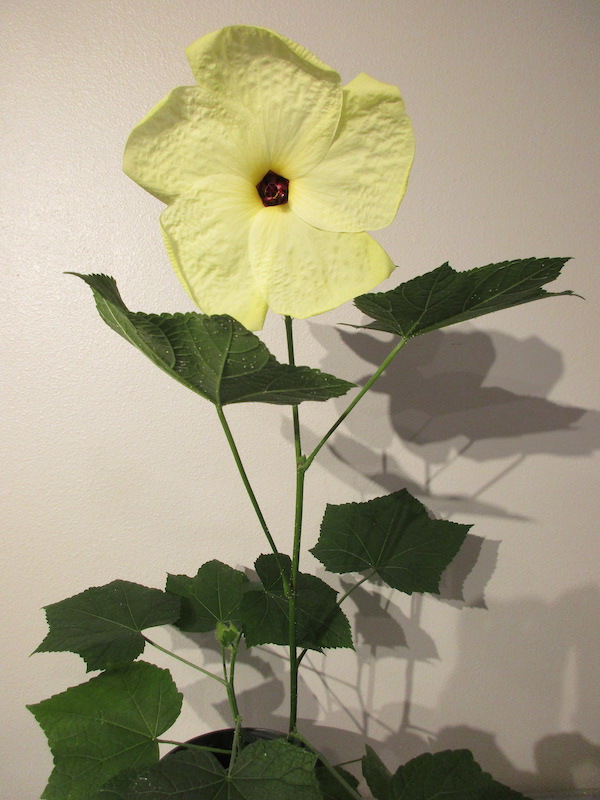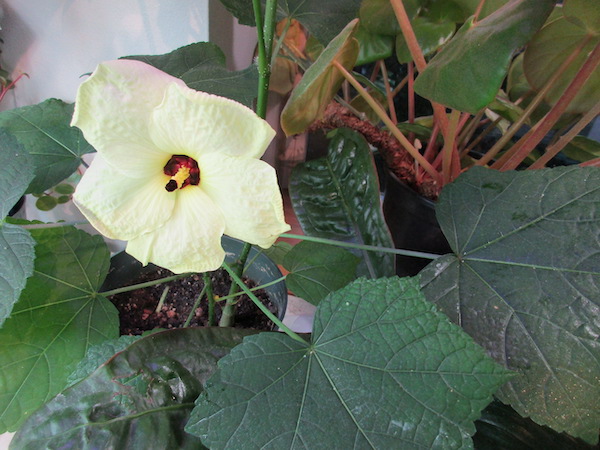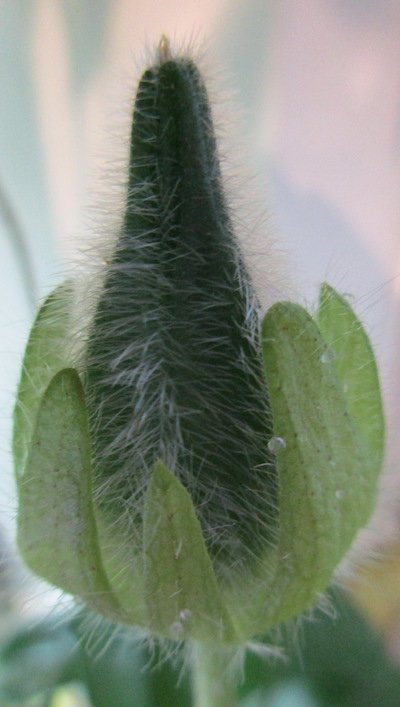Plant of the Month: November 2021
|
| Edible Hibiscus |
| Hibiscus Manihot L. |
| = Abelmoschus Manihot (L.) Med. |
MALVACEÆ; Mallow Family
|
| On August 24th, I sowed 5 seeds of a plant. Two sprouted and grew. By November 16th, the first flower opened. Here is the whole story. |
| Hibiscus Manihot, from tropical Pakistan through the Philippines to N Australia, was named in 1753 by Linnæus. In 1787, Medicus renamed it Abelmoschus Manihot. To this day, one choose whether to use one generic concept or another. Since the distinctions are trivial between Hibiscus in the narrow sense, and Abelmoschus, I lump the two genera rather than split them. |
| Conceived broadly, Hibiscus consists of 675 species from warm temperate to tropical regions globally. If you choose to split, Abelmoschus consists of about 11 species. The best known Abelmoschus species is Okra, Abelmoschus esculentus. |
| Though many Hibiscus are cultivated for floral beauty, and some are now familiar as ornamentals, a significant number are also food sources. At least 74 Hibiscus species have been eaten by humans. |
| Our present subject is also called in English Sunset Hibiscus, Goldenbowl Hibiscus, Manihot Mallow, and Tree Spinach. It is a perennial plant or subshrub, that can flower when anywhere from 7 inches to 12 feet high. Its leaves are green, thin, practically hairless, up to 12 (18) inches, and shaped maple-like. They vary in depth of their lobing (my strain my be the 'Green Jade' cultivar). The flowers measure 5 to 9 inches wide, opening in morning, and sadly lasting one day only. Fleeting, exquisite and lovely, their petals are yellow or cream colored, with their hearts dark purplish like an eye's pupil. A short plump stiff-hairy seedpod ensues. |
| All parts of the plant are edible but the leaves are the main food. Franklin W. Martin considered it in the top 10 of edible leaves of the tropics. He wrote "it will outyield most crops and give much more for the effort than most other green-leaved vegetables." Like most members of the Mallow Familiy, they are mucilgainous, and possess scarcely any flavor --mere chlorophyll taste. A name is Slippery Cabbage. But the young growing shoots and leaves are high in protein. Frying the leaves, rather than chewing them raw, is advisable. The peeled root is also eaten; and the seedpod; and the seeds yield a fatty oil. |
In my experience, growing it indoors in Seattle as a potted houseplant, I had to water it often, and keep it warm and well fertilized. It grew rapidly. I shall await learning whether it behaves as a reliable perennial vegetable, or not. Some cultivars of this species are grown from cuttings, but even then may prove to endure for only a few years. Both my little plants are forming seedpods, and presemably will ripen seeds identical to their own DNA, because no cross pollination occurred. I may update this article when there is more news to report. (After my plant ripened seeds, I cut it down, but it grew back to 5 feet and bloomed again in May 2022.)
Back |

Hibiscus Manihot ; photo by ALJ
|

Hibiscus Manihot in ALJ apartment; photo by ALJ
|

Hibiscus Manihot ; photo by ALJ
|

Hibiscus Manihot ; photo by ALJ
|

Hibiscus Manihot unripe seedpod; photo by ALJ
|

Hibiscus Manihot ripe seedpod; photo by ALJ
|
|
|

